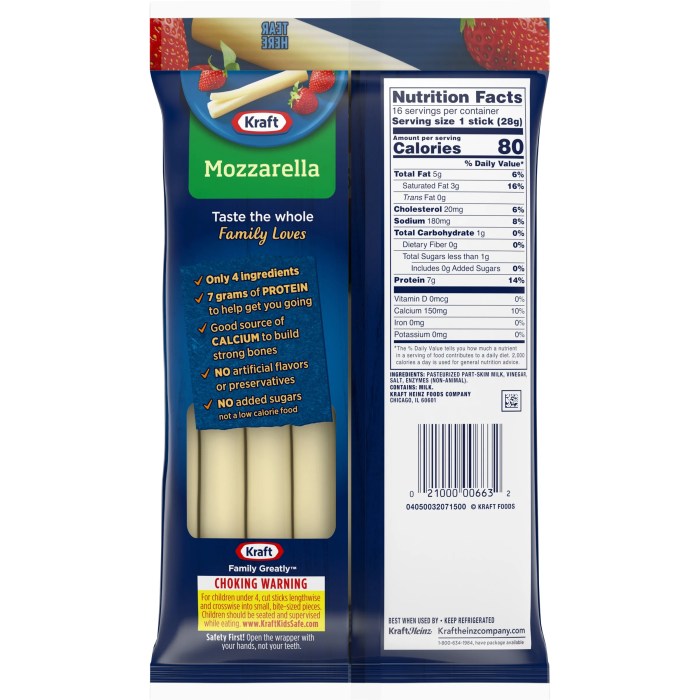Ingredients and Allergens: Kraft Mozzarella String Cheese Nutrition

Kraft mozzarella string cheese nutrition – Kraft Mozzarella String Cheese, like many processed foods, contains a specific list of ingredients and may present potential allergens. Understanding these aspects is crucial for consumers with dietary restrictions or allergies. This section details the ingredients, identifies potential allergens, and discusses processing methods that may influence nutritional content.
The ingredient list and allergen information can vary slightly depending on the specific flavor and packaging size of the Kraft Mozzarella String Cheese. Always refer to the label on the specific product you are purchasing for the most up-to-date and accurate information.
Ingredient Composition
Generally, Kraft Mozzarella String Cheese contains ingredients such as pasteurized part-skim milk, mozzarella cheese (part-skim milk, cheese culture, salt, enzymes), whey, milkfat, salt, and possibly other ingredients depending on the specific product. These ingredients contribute to the cheese’s texture, flavor, and overall nutritional profile. The exact proportions of each ingredient are usually not explicitly stated on the packaging, but the order listed generally indicates the concentration of each ingredient, with the most abundant ingredient listed first.
Allergens Present
Because of its primary ingredients, Kraft Mozzarella String Cheese contains several potential allergens. Consumers should carefully examine the product label for the most current and accurate allergen information.
- Milk: This is a major allergen present in significant quantities. Individuals with milk allergies should avoid this product.
- Whey: A byproduct of cheesemaking, whey is also a common milk allergen.
- Enzymes: While the specific enzymes used are not always listed, some individuals may have sensitivities to certain types of enzymes used in cheese production.
Processing Methods and Nutritional Value
The processing methods employed in the manufacturing of Kraft Mozzarella String Cheese can affect its nutritional value. While the exact details of the manufacturing process are often proprietary information, some general aspects can be considered.
Okay, so you’re all about that Kraft mozzarella string cheese life, right? Knowing the nutrition facts is key, but sometimes you wanna switch it up. If you’re curious about other options, check out the nutritional info for polly-o string cheese nutrition to compare. Then you can totally decide which cheesy snack reigns supreme in your world – Kraft or Polly-O?
The choice is yours, dude.
- Pasteurization: The pasteurization of milk, a standard step in cheesemaking, eliminates harmful bacteria but can also slightly reduce some heat-sensitive nutrients.
- Salt Addition: The addition of salt contributes to flavor and preservation but can increase the sodium content of the product. Individuals watching their sodium intake should be mindful of this.
- Forming and Packaging: The process of shaping the cheese into strings and packaging it may not significantly alter the nutritional profile but may affect the shelf life and moisture content.
Serving Size and Caloric Intake

Kraft Mozzarella String Cheese provides a convenient and enjoyable snack or addition to a meal. Understanding the serving size and corresponding caloric intake is crucial for managing personal dietary needs and goals. This section details the standard serving size and provides calculations for caloric intake based on varying consumption amounts.
Standard Serving Size and Caloric Content
A standard serving of Kraft Mozzarella String Cheese consists of one (1) stick. The exact caloric content per stick may vary slightly depending on the specific product and packaging, but a reliable estimate for a single stick is approximately 70 calories. This value is based on information readily available on Kraft’s website and product packaging. It’s important to always refer to the nutrition label on the specific package for the most accurate information.
Caloric Intake for Multiple Servings
The caloric intake increases proportionally with the number of servings consumed. For example, consuming two (2) sticks of Kraft Mozzarella String Cheese would result in an approximate caloric intake of 140 calories (70 calories/stick x 2 sticks). Similarly, consuming three (3) sticks would equate to approximately 210 calories (70 calories/stick x 3 sticks). This linear relationship allows for easy calculation of caloric intake for any number of servings.
Caloric Intake Table
The following table summarizes the approximate caloric intake for various serving sizes of Kraft Mozzarella String Cheese:
| Number of Servings | Approximate Caloric Intake |
|---|---|
| 1 | 70 calories |
| 2 | 140 calories |
| 3 | 210 calories |
| 4 | 280 calories |
| 5 | 350 calories |
Nutritional Impact and Dietary Considerations

Kraft Mozzarella String Cheese, while a convenient and appealing snack, plays a specific role within a balanced diet. Its nutritional profile necessitates careful consideration regarding its frequency of consumption and integration into broader dietary plans. Understanding its impact on various dietary needs is crucial for informed consumption.Kraft Mozzarella String Cheese’s suitability within various dietary approaches depends on individual needs and overall caloric intake.
While it provides a source of protein and calcium, its fat and sodium content must be considered within the context of a balanced meal plan.
Role in a Balanced Diet
Kraft Mozzarella String Cheese can contribute to a balanced diet by providing protein, calcium, and some essential nutrients. However, it should be consumed in moderation as part of a larger dietary plan that includes a variety of fruits, vegetables, whole grains, and lean proteins. Over-reliance on processed cheese products like string cheese can lead to an imbalance in nutrient intake and potentially contribute to higher overall fat and sodium consumption.
A balanced diet should prioritize whole, unprocessed foods. For example, incorporating string cheese as a snack alongside an apple and a handful of almonds offers a more balanced nutritional profile compared to consuming it alone.
Suitability for Various Dietary Needs, Kraft mozzarella string cheese nutrition
Kraft Mozzarella String Cheese’s suitability varies across different dietary needs. For individuals following a low-carb diet, its relatively low carbohydrate content makes it a viable option. However, the fat content should still be monitored within the overall daily allowance. For high-protein diets, it offers a moderate source of protein, but other higher-protein sources should also be included. For those with sodium restrictions, it’s crucial to be mindful of the sodium content per serving and limit consumption accordingly.
A person on a low-sodium diet might opt for a lower-sodium cheese alternative or consume string cheese sparingly.
Potential Health Benefits and Drawbacks
The potential health benefits of Kraft Mozzarella String Cheese are primarily related to its calcium and protein content, which support bone health and muscle development. However, regular consumption can lead to drawbacks if not managed within a balanced diet. The relatively high saturated fat and sodium content can contribute to elevated cholesterol levels and blood pressure if consumed excessively.
Moderation is key. For instance, substituting string cheese for a less healthy snack like chips can be beneficial, but over-consumption could negate these positive effects.
Incorporation into Different Meal Plans
Kraft Mozzarella String Cheese can be incorporated into various meal plans. It can serve as a convenient snack between meals or added to lunchboxes. It can also be included in salads, as a topping for soups or incorporated into quick meals such as quesadillas. A simple example would be adding string cheese to a salad for added protein and flavor, or using it as a component in a quick and easy pasta dish.
Its versatility allows for diverse integration, provided it remains part of a balanced and varied meal plan.
Popular Questions
Is Kraft Mozzarella String Cheese a good source of calcium?
Yes, it’s a decent source of calcium, contributing to your daily recommended intake. However, the exact amount varies depending on the serving size.
Does Kraft Mozzarella String Cheese contain any artificial colors or flavors?
Check the ingredient list on the specific product packaging as formulations can vary. Many versions aim for minimal artificial additives, but it’s always best to verify directly.
How does the sodium content of Kraft Mozzarella String Cheese compare to other processed cheeses?
Sodium content can vary significantly among processed cheeses. Comparing nutrition labels of different brands and types will give you the best understanding of relative sodium levels.
Can I freeze Kraft Mozzarella String Cheese?
While freezing is possible, the texture might change upon thawing. It’s best consumed fresh for optimal taste and texture.


